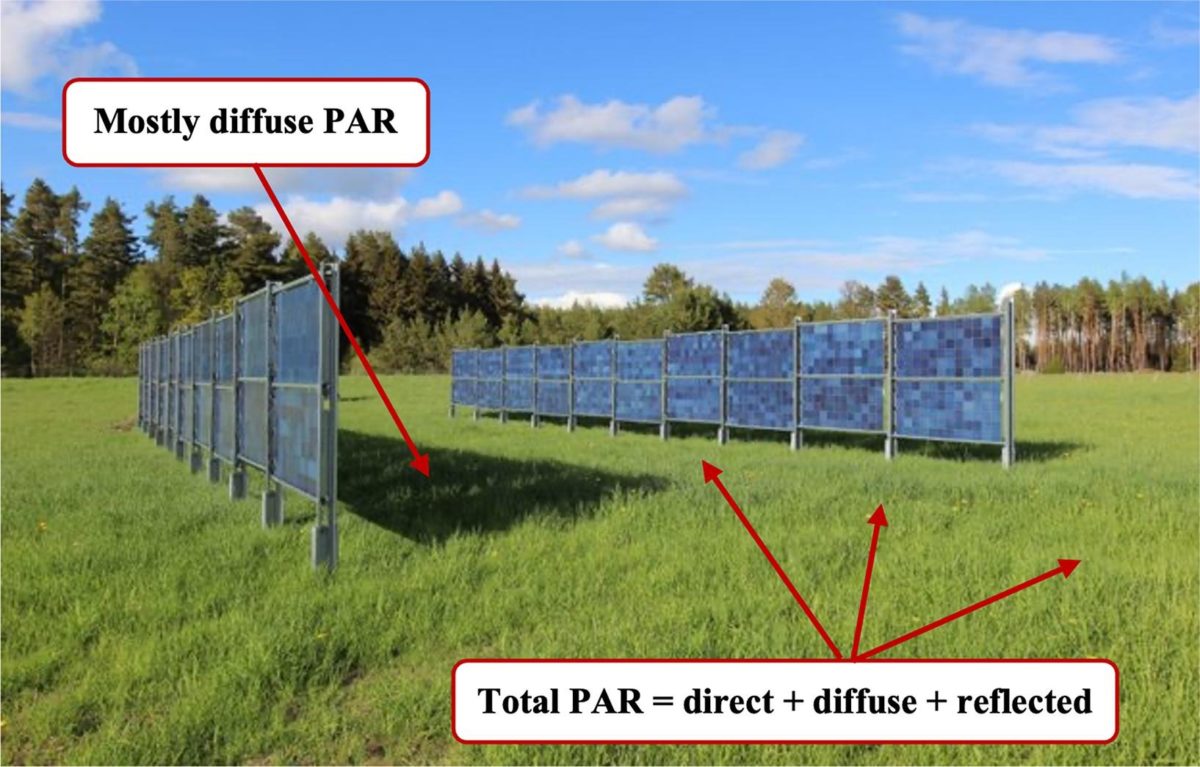An international research group has developed a new way to estimate photosynthetically active radiation (PAR) and predict the crop yield in agrivoltaic projects.
“We have re-parameterized and applied state-of-the-art models for global horizontal irradiance (GHI) decomposition to assess (PAR) in agrivoltaics, which is an important variable in order to properly predict the crop yield,” researcher Silvia Ma Lu told pv magazine.
PAR is light of wavelengths 400 nanometers (nm) to 700 nm and is the portion of the light spectrum used by plants for photosynthesis.
“While for PV systems the key term is GHI, for crops, the analogous term is PAR,” the scientists explained. “PAR reaching the ground surface has two primary incoming streams, similarly to the incoming GHI. These are ‘diffuse' and ‘direct,' and their values are essentially affected by the quantity of clouds and aerosols in the atmosphere.”
The researchers used decomposition models of solar radiation, which are commonly applied to estimate diffuse horizontal irradiance (DHI) from measured GHI, to predict accurately diffuse PAR in agrivoltaic plants. They checked the applicability of seven standalone GHI decomposition models for PAR decomposition.
“It is known that, per unit of total PAR, diffuse PAR is more efficient for canopy photosynthesis than is direct PAR,” they said. “For this reason, it is essential to estimate the diffuse PAR component when agrivoltaic systems are being assessed, to properly predict the crop yield. The solar panels installed in the system cast shadows on the crops throughout the day and in these shaded areas, the crops receive mainly diffuse PAR.”
The proposed methodology is reportedly applicable to all types of crops and all types of agrivoltaic installations.
“It requires temporal and spatial knowledge of the shaded crop areas along the day and a crop model that differentiates diffuse and direct PAR to eventually predict the crop yield in an agrivoltaic system,” Lu said.
Popular content
The academics re-parameterized and applied the models at three different locations in Sweden – Lanna, Hyltemossa and Norunda. PAR and PAR diffuse measurements were available for them, as they all belong to the Integrated Carbon Observation System stations network. They applied the normalized root mean square error (nRMSE) model, where lower values are preferred, to indicate the accuracy performance of the modules.
“The nRMSE values ranging between 27% and 43% illustrate the high variability and weak performance of most of the stand-alone models because the models’ coefficients have been previously fitted in other locations with different climate conditions” they said. “Re-parameterization of the models is highly recommended if measured data of the investigated location is available.”
They achieved the highest normalized root mean square error (nRMSE) of 35.24% in Lanna and the lowest one of 23.75% in Norunda. They added that Ensemble model output statistics (EMOS), a parametric post-processing framework for making probabilistic predictions, may also be used in this case to provide further accuracy.
“EMOS takes the estimations of the above-mentioned models and outputs a predictive distribution with parameters optimized by maximum likelihood estimation,” Lu said. “Results show that EMOS can provide further accuracy in the estimation of the diffuse component of PAR, lowering the nRMSE to 23.02% in Norunda for example. The drawback of EMOS is that it requires the inputs of all the models forming the ensemble.”
The research team includes scientists from Università Cattolica del Sacro Cuore in Italy and Mälardalen University in Sweden. The academics described their approach in “Photosynthetically active radiation decomposition models for agrivoltaic systems applications,” which was recently published in Solar Energy. The research received financial support from the Swedish Energy Agency and the Swedish Research Council for Sustainable Development (FORMAS).
“These results can be used to perform estimations of the PAR diffuse component in Sweden wherever ground measurements are not available,” the team concluded. “The overall methodology can be similarly applied to other countries.”
Other researchers at Mälardalen University recently investigated how to optimize electricity yields in agrivoltaic installations with vertically mounted bifacial PV modules. They developed a techno-economic optimization model that purportedly outlines the ideal design parameters for an agrivoltaic vertical PV system by combining climatological data with figures on expected solar power generation, shading distribution, water for irrigation, and agricultural yield. In particular, the proposed model takes into account how much PAR is received on the crops.
This content is protected by copyright and may not be reused. If you want to cooperate with us and would like to reuse some of our content, please contact: editors@pv-magazine.com.



8 comments
By submitting this form you agree to pv magazine using your data for the purposes of publishing your comment.
Your personal data will only be disclosed or otherwise transmitted to third parties for the purposes of spam filtering or if this is necessary for technical maintenance of the website. Any other transfer to third parties will not take place unless this is justified on the basis of applicable data protection regulations or if pv magazine is legally obliged to do so.
You may revoke this consent at any time with effect for the future, in which case your personal data will be deleted immediately. Otherwise, your data will be deleted if pv magazine has processed your request or the purpose of data storage is fulfilled.
Further information on data privacy can be found in our Data Protection Policy.